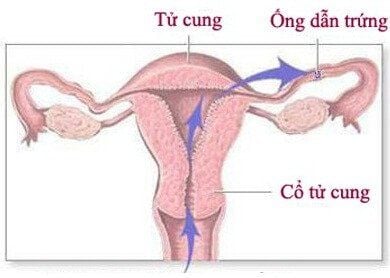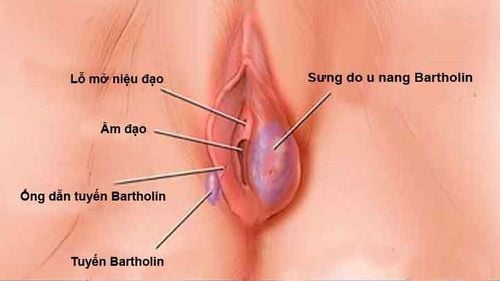This is an automatically translated article.
The article was professionally consulted by Specialist Doctor I Nguyen Thi Man - Department of Obstetrics and Gynecology - Vinmec Danang International General Hospital. The doctor has more than 10 years of experience in diagnosing, consulting and treating in the field of Obstetrics and Gynecology.Tubal ablation is a procedure that removes one or both fallopian tubes. Depending on the purpose of the surgery, tubal ablation is sometimes combined with removal of the ovaries and uterus. These procedures can all be performed by traditional open surgery or laparoscopic surgery.
1. What is tubal ablation?
The fallopian tubes are the passage through which an egg travels from the ovary to the uterus. Tubalectomy is surgery to remove one side of the fallopian tube (partial) or both sides (total).Tubalectomy can be done alone or in combination with other procedures, including oophorectomy, hysterectomy, and total intrauterine cesarean section.
2. Indications for tubal ablation
Tubalectomy can be performed to treat a number of problems related to a woman's reproductive tract health. Usually, the doctor will recommend the patient to remove the fallopian tubes in the following cases:Ectopic pregnancy; Obstruction of one or both fallopian tubes; rupture of one or both fallopian tubes; Inflammation of the fallopian tubes; Fallopian tube cancer. In particular, the incidence of fallopian tube cancer is very rare and is only common in women with BRCA gene mutations. Lesions that occur in the fallopian tubes are also present in only about half of patients who carry the BRCA gene mutation and have had ovarian cancer.
Studies have found that some types of ovarian cancer originate in the cells inside the fallopian tubes. Therefore, tubal ablation offers hope to reduce the risk of ovarian cancer.
In addition, this procedure is also known as a permanent method of birth control (sterilization).

3. Preparation for surgery
The surgeon will discuss the procedure with the patient, as well as provide pre- and post-operative instructions. This information may vary depending on whether the surgery is open or laparoscopic. Determining the type of surgery must also be based on factors such as: reason for surgery, age and health status of the patient.Here are a few things to prepare before surgery:
Organize your work and take time to fully rest after surgery. When discharged from the hospital, the patient may still be stunned by the effects of anesthesia and pain at the incision site; Ask your doctor what medications are allowed before, during, and after surgery; Know the requirements for fasting time before surgery; Prepare loose and comfortable clothes to wear when you get home.
4. Procedure for surgery
4.1. Traditional open surgery Right before the surgery, the patient will be under general anesthesia. Then, the doctor will make an incision about a few centimeters long in the patient's lower abdomen. Through this incision, the fallopian tubes are seen and removed from the body. Finally, the open incision will be sutured with specialized stitches.4.2. Laparoscopic surgery Laparoscopy is a minimally invasive procedure that can be performed under general or local anesthesia.
The doctor makes a small incision in the patient's lower abdomen and inserts a laparoscope (a long tube with a light and camera on the end). During surgery, air is pumped into the abdomen allowing the surgeon to see the pelvic organs more clearly on the computer screen.
After that, several other small incisions will also be made to insert the tools to remove the fallopian tubes. These incisions are only about 1cm long and will be sutured as soon as the fallopian tubes have been removed.
5. Recovery after surgery
After surgery, the patient will be taken to the recovery room for observation. It will take some time for the patient to be fully awake after the anesthesia, and nausea and mild pain around the incision may also appear.The patient will stay in the outpatient department until he can stand up and urinate normally before being discharged.
It is necessary to follow the doctor's instructions in post-surgery activities to be able to recover quickly after a few days. Patients should avoid heavy lifting or vigorous exercise for at least a week.
After returning home, the doctor should be informed immediately if the patient experiences one of the following signs:
Fever and chills; The wound is very painful or nauseated; Purulent discharge or redness around the incision; Sudden heavy vaginal bleeding; Unable to urinate. Incisions from laparoscopic surgery are smaller and tend to heal faster than those from open surgery. Recovery time will vary from person to person, but in general, full recovery is within 3 to 6 weeks for open surgery or 2 to 4 weeks after laparoscopic surgery.

6. Potential Complications
Any type of surgery carries risks, mainly reactions to the anesthetic. Laparoscopic tubal resection takes longer than open surgery, so the patient is under anesthesia for longer. Other risks of tubal ligation include:Infection: Compared with open surgery, the risk of infection with laparoscopic surgery is lower; Internal bleeding or bleeding at the surgical site; Abdominal hernia; Damage to blood vessels or nearby organs. However, a study of women who had a tubal ablation combined with a cesarean section found that the incidence of complications was very rare.
7. Possibility of menstruation and pregnancy
The overall prognosis of tubal ligation surgery is quite good. If the ovaries and uterus are still present, a woman will continue to menstruate after surgery.Removal of only one fallopian tube will not result in sterilization, so women still need to use contraception afterwards. On the other hand, removing both fallopian tubes means that a woman cannot get pregnant naturally, nor does she need to use contraception. However, if there is still a uterus, a woman can get pregnant with the help of in vitro fertilization (IVF). Therefore, before having a tubal ablation surgery, the patient needs to clearly explain to the doctor about their desire to have children in the future.
Although it takes a longer recovery time, laparoscopic tubal ligation is still considered a safe alternative to tubal ligation. This procedure not only provides an absolute contraceptive effect, but also plays a certain role in protecting women from dangerous ovarian cancer. In conclusion, laparoscopic tubal ablation is an option worth considering for women desiring sterilization or having problems with the genital tract.
Please dial HOTLINE for more information or register for an appointment HERE. Download MyVinmec app to make appointments faster and to manage your bookings easily.
Reference source: healthline.com













